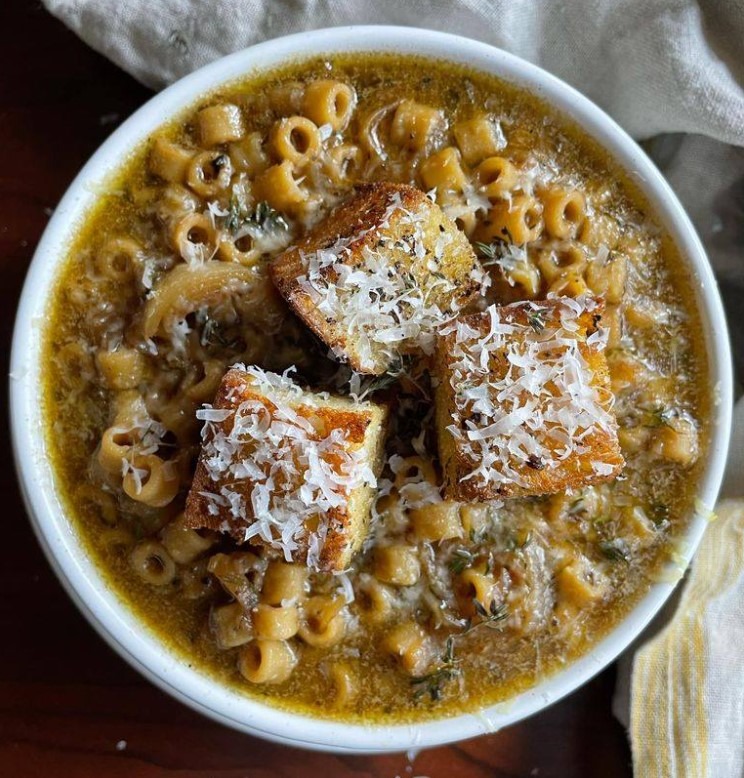French Onion Soup: A Hearty and Timeless Classic
French onion soup is one of the most popular and comforting soups in the world. Its simple yet rich and savory flavor profile, combined with its warm and satisfying texture, make it a go-to dish for many occasions, from cozy winter nights to fancy dinner parties. While the recipe has evolved over time and across cultures, the basic ingredients and techniques remain the same: caramelized onions, beef broth, bread, and cheese. In this article, we’ll explore the history and variations of French onion soup, as well as its nutritional benefits and tips for making it at home.
Origins and History
The origins of French onion soup can be traced back to the Roman Empire, where onion was a common ingredient in many dishes, especially soups and stews. However, the modern version of French onion soup that we know and love today was popularized in the 18th century by French chefs who used beef broth, bread, and cheese to make a more sophisticated and filling soup that could be served as a main course. Over time, the recipe spread to other countries, such as the United States, where it became a staple of French cuisine and a classic comfort food.
Variations and Adaptations
While the basic ingredients and techniques of French onion soup remain the same, there are many variations and adaptations that reflect local and personal preferences. For example, some recipes call for chicken or vegetable broth instead of beef broth, or add wine or beer for extra flavor. Some recipes use different types of cheese, such as Gruyère, Swiss, or cheddar, and some even add crème fraîche or sour cream to the broth. Some recipes also use different types of bread, such as baguette, ciabatta, or sourdough, and some toast or grill the bread before adding it to the soup. These variations and adaptations make French onion soup a versatile and customizable dish that can suit any taste and occasion.
Nutritional Benefits
French onion soup is not only delicious but also nutritious. Onions, the main ingredient, are low in calories and high in fiber, vitamin C, and antioxidants, which can help boost immunity, lower inflammation, and improve digestion. Beef broth, another key ingredient, is rich in protein, vitamins, and minerals, such as iron, zinc, and magnesium, which can help build and repair tissues, support the immune system, and regulate blood pressure. Bread, although not as nutritious as onions or beef broth, can provide carbohydrates, fiber, and some vitamins and minerals, depending on the type of bread used. Cheese, while high in fat and calories, can provide calcium, protein, and flavor, in moderation.
Tips for Making French Onion Soup
Making French onion soup at home can be a rewarding and satisfying experience, but it also requires some patience and attention to detail. Here are some tips to help you make the best French onion soup possible:
- Use good-quality ingredients, especially onions and beef broth. The better the quality, the better the flavor.
- Caramelize the onions slowly and evenly, over low heat, to develop their natural sweetness and depth of flavor. This may take up to 30 minutes or more, but it’s worth the effort.
- Add the broth gradually, stirring constantly, to avoid lumps and ensure that the onions are fully submerged.
- Simmer the soup for at least 30 minutes, or longer, to allow the flavors to meld and the broth to reduce slightly.
- Toast or grill the bread and cheese separately, and add them to the soup just before serving, to prevent them from becoming soggy or mushy.
- Season the soup to taste with salt, pepper, and any other herbs or spices that you like, such as thyme, bay leaves, or Worcestershire sauce.
- Serve the soup hot, garnished with more cheese, croutons, and fresh herbs, if desired.
French onion soup is a timeless classic that has stood the test of time and remained a favorite of many foodies and home cooks around the world. Its simplicity, heartiness, and versatility make it a perfect dish for any occasion, from a quick lunch to a fancy dinner. By understanding the history and variations of French onion soup, as well as its nutritional benefits and tips for making it at home, you can elevate this dish to a whole new level and impress your family and friends with your culinary skills. So why not give it a try and see for yourself why French onion soup is a beloved classic that never gets old?
To make this soup, you’ll need:
- 6 yellow or white onions
- 6 cloves of garlic
- A bundle of fresh thyme
- 2 bay leaves
- 1 tablespoon of Worcestershire sauce
- 1 tablespoon of Dijon mustard
- 8 cups of beef stock
- 1 pound of ditalini pasta
- 1 Parmesan rind
- Butter
- Olive oil
Instructions:
- Peel and slice the onions and garlic. Heat some butter and olive oil in a large Dutch oven over medium heat. Add the onions and garlic, season with salt and pepper, and cook for about 25 minutes, stirring occasionally, until soft and golden brown.
- Add the Worcestershire sauce, Dijon mustard, bay leaves, fresh thyme, Parmesan rind, and beef stock to the pot. Bring to a simmer and let it cook for as long or as little as you like, depending on how much time you have and how flavorful you want the soup to be.
- About 8 to 10 minutes before you’re ready to serve the soup, add the ditalini pasta to the pot and let it cook until al dente. Taste the soup and adjust the seasoning with more salt and pepper if needed.
- To make the croutons, preheat the broiler and line a baking sheet with parchment paper. Cut some day-old bread into cubes and toss them with olive oil, garlic powder, grated Parmesan, and Italian seasoning. Spread the bread cubes in a single layer on the prepared baking sheet and broil for a few minutes, until golden brown and crispy.
- Serve the soup hot with the Parmesan croutons on top. Enjoy!








